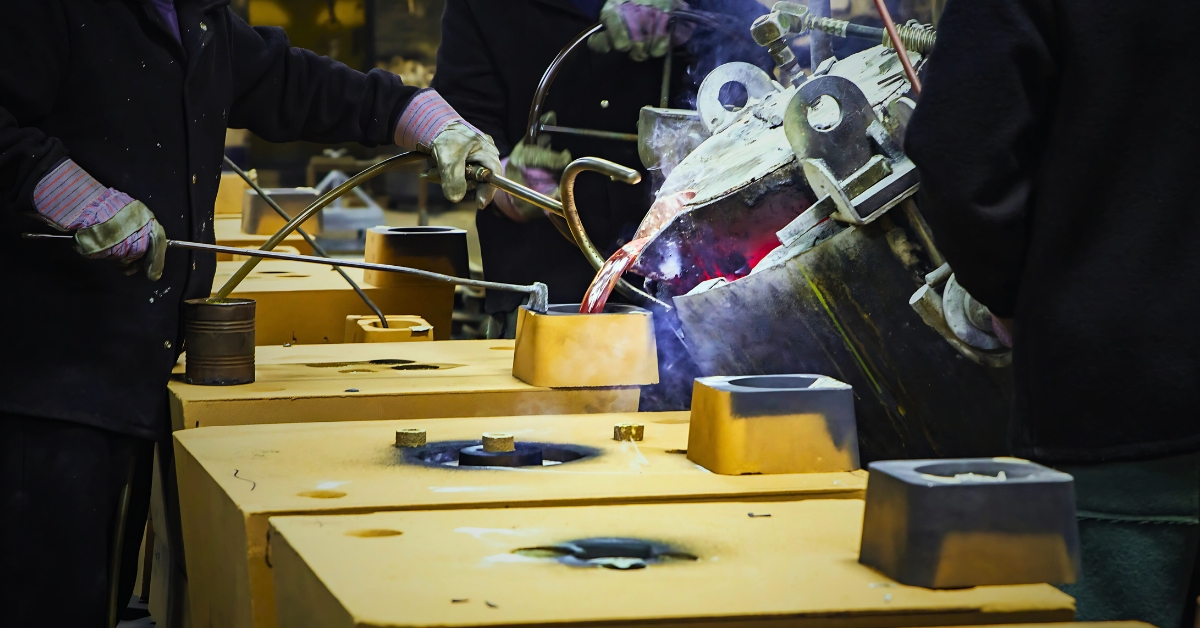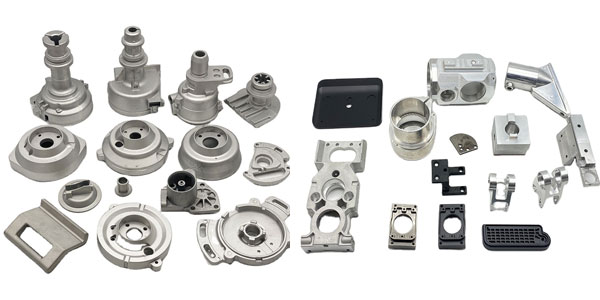Learn more about Aluminum Foundry and its role in successful aluminum casting
Wiki Article
A Comprehensive Overview to the Production Techniques Employed in an Aluminum Foundry
The production strategies employed in aluminum foundries are critical and varied to the industry. Each method, from sand casting to additive manufacturing, supplies unique benefits tailored to certain manufacturing demands. Comprehending these strategies can significantly influence product high quality and performance. As the need for innovative production proceeds to grow, the relevance of mastering these techniques can not be overemphasized. What ramifications do these improvements hold for the future of aluminum production?Understanding Light Weight Aluminum Alloys and Their Characteristic
Aluminum alloys play an important role in the production procedure because of their diverse homes and applications. These alloys are largely categorized right into two groups: wrought and cast alloys, each with distinctive features. Wrought alloys, such as the 6000 and 7000 collection, are recognized for their exceptional strength-to-weight ratio and corrosion resistance, making them ideal for architectural applications. In comparison, cast alloys, including the 2000 and 3000 series, exhibit premium fluidness and can be easily formed right into complicated shapes.
The particular properties of light weight aluminum alloys, such as tensile stamina, ductility, and thermal conductivity, are affected by their chemical make-up and handling techniques. Components like copper, magnesium, and silicon are generally contributed to enhance these properties, tailoring the alloys for particular usages in aerospace, automotive, and building and construction markets. Understanding these alloys and their habits is vital for maximizing manufacturing procedures and guaranteeing premium end results in light weight aluminum Foundry procedures.
Sand Spreading: A Conventional Approach for Aluminum Production
Sand spreading is a commonly used strategy in aluminum manufacturing that entails creating a mold from sand to shape the steel. This method uses a number of benefits, such as cost-effectiveness and the capacity to produce complicated forms, while also providing specific downsides, including surface finish limitations and slower manufacturing prices. Aluminum Foundry. Understanding both the procedure and its advantages and disadvantages is crucial for reviewing its suitability in numerous applicationsProcess Introduction
One of one of the most long-lasting techniques in metal spreading, sand casting provides a dependable technique for creating aluminum parts. This procedure starts with creating a mold from a mix of sand and a binding representative, which is formed to match the wanted part. When the mold is prepared, liquified light weight aluminum is put right into the dental caries, allowing it to take and load the room on the mold's shape. After cooling, the mold is broken away to expose the cast aluminum component. Any essential ending up procedures, such as machining or surface area treatment, can after that be related to accomplish the last specs. Sand spreading is extensively made use of as a result of its convenience, allowing the production of intricate forms and varying sizes efficiently.Advantages and Disadvantages
The sand casting process presents a distinct set of benefits and drawbacks that influence its application in light weight aluminum manufacturing. One considerable benefit is its versatility, permitting the manufacturing of intricate forms and sizes. Additionally, sand spreading is cost-effective for reduced to tool production quantities, calling for very little tooling. It additionally has drawbacks, such as lower dimensional accuracy and surface coating compared to even more advanced techniques. The process can be labor-intensive, calling for knowledgeable labor for mold preparation and putting. Additionally, the production rate may be slower, restricting its efficiency for high-volume applications. Generally, while sand casting remains a feasible option for lots of aluminum parts, its limitations need to be considered in the context of details production demands.Pass Away Casting: Accuracy and Effectiveness in Production
Pass away casting stands as a keystone of aluminum Foundry manufacturing, supplying unequaled precision and efficiency. This method includes requiring liquified aluminum into a steel mold and mildew under high pressure, causing regular and extremely exact elements. The process allows for tight tolerances and elaborate styles, making it perfect for applications in vehicle, aerospace, and consumer goods.The efficiency of die casting is noticeable in its rapid manufacturing prices, which considerably reduce lead times. Furthermore, the approach decreases waste, as excess metal can be reused. The resilience of die-cast components enhances the long life of products, reducing the demand for constant substitutes.
Pass away casting supports various surface coatings and second operations, adding to its convenience. This combination of rate, accuracy, and material preservation settings die casting as a preferred choice for makers seeking affordable solutions without compromising quality. In the affordable landscape of light weight aluminum Foundry practices, pass away spreading stays a crucial method.
Investment Casting: Getting Complex Geometries
Although typically outweighed by die spreading, financial investment spreading plays a substantial duty in aluminum Foundry production by enabling the production of elements with elaborate geometries and fine information. This strategy involves developing a wax pattern, which is covered in a ceramic covering. Once the shell sets, the wax is disappeared, leaving a dental caries that reflects the preferred form of the end product.Financial investment casting is especially advantageous for creating intricate components that may be difficult or challenging to attain through other techniques. The procedure permits high dimensional accuracy and a smooth surface area coating, reducing the requirement for extensive machining. Additionally, it supports a wide variety of alloys, enhancing its flexibility in making applications. By utilizing investment casting, foundries can satisfy the needs of sectors such as aerospace, automotive, and medical, where precision and complexity are extremely important.
The Duty of Additive Production in Aluminum Foundries
Additive manufacturing is progressively acknowledged for its transformative capacity in aluminum factories, using advantages such as lowered product waste and enhanced design flexibility. Various methods, including 3D printing and binder jetting, are being embraced to improve production processes and improve efficiency. As the sector develops, future patterns may further integrate additive production, improving typical Foundry techniques.Benefits of Additive Manufacturing
As the production landscape develops, the combination of additive manufacturing in aluminum factories presents a transformative change in manufacturing abilities. This innovative strategy provides several considerable advantages, consisting of decreased product waste, as it enables exact layering and marginal excess. In addition, additive manufacturing helps with rapid prototyping, making it possible for quicker iterations and changes throughout the style phase. This modern technology likewise supports the production of complicated geometries that typical methods may have a hard time to achieve, boosting product performance and performance. Furthermore, it can streamline supply chains by allowing local production, reducing transport costs and preparation. Eventually, the adoption of additive manufacturing encourages light weight aluminum foundries to boost efficiency, enhance item high quality, useful site and fulfill the growing demand visit our website for modification in manufacturing.
Typical Strategies Made Use Of
Exploring the landscape of aluminum foundries exposes a selection of usual strategies that leverage additive manufacturing to boost manufacturing processes. One widespread approach is the usage of 3D printing for developing complex molds, which permits complex designs that typical approaches can not attain. This technique decreases product waste and reduces preparations substantially. In addition, binder jetting is employed to produce sand molds directly from digital designs, enhancing the manufacture process. An additional technique includes the combination of metal additive production, which allows the production of highly tailored aluminum parts. These methods not only improve efficiency but also add to advancement in style, allowing shops to satisfy diverse customer needs while keeping top quality requirements.
Future Patterns in Sector
While the light weight aluminum Foundry industry has actually typically relied upon standard manufacturing approaches, the assimilation of additive production is poised to redefine manufacturing standards. This innovative technique enables the production of complex geometries that are frequently impossible to attain through standard spreading strategies. By allowing quick prototyping and decreasing product waste, additive production improves performance and sustainability within aluminum shops. Furthermore, this technology assists in customization, enabling producers to meet certain customer needs without considerable retooling. As the market welcomes digitalization, advancements in 3D printing innovations will likely lead to quicker manufacturing cycles and reduced lead times. The future of light weight aluminum factories is progressively linked with the advantages and abilities supplied by additive production. Supplied High Quality Control Procedures in Light Weight Aluminum Foundries Quality assurance actions in light weight aluminum foundries are basic to assure the stability and performance of cast products. These steps consist of rigorous evaluation procedures, which incorporate both aesthetic analyses and progressed screening methods such as X-ray radiography and ultrasonic testing. Checking crucial parameters, such as temperature and alloy structure during the melting and pouring procedures, is important to guarantee the desired material residential properties.In addition, adherence to standard treatments, such as ISO accreditations, assists preserve constant quality. Statistical procedure control (copyright) methods are usually employed to assess production data, allowing for the identification of fads and potential defects early in the production cycle.

Future Patterns and Advancements in Aluminum Casting Techniques
As the light weight aluminum spreading sector progresses, innovative methods are arising to boost efficiency and product top quality. One noteworthy pattern is the integration of advanced automation and robotics, which improve procedures and lower labor costs. This shift permits consistent precision in spreading, decreasing defects and enhancing overall outcome.Furthermore, the fostering of 3D printing modern technology for pattern-making is acquiring grip, making it possible for rapid prototyping and the production of complex geometries that typical methods struggle to achieve. The use of simulation software application promotes much more accurate predictions of product actions during casting, leading to optimized layouts and lowered waste.
Sustainability is additionally a focal point, with efforts toward recycling light weight aluminum scrap and embracing green techniques in shops. These technologies show a commitment to advancing aluminum spreading methods, making sure improved performance, lowered ecological impact, and adaptability to market needs. The future of aluminum spreading promises considerable improvements that will improve the market check that landscape.
Frequently Asked Questions
What Precaution Are Carried Out in Aluminum Foundries?
Security steps in light weight aluminum factories include individual protective equipment, air flow systems, regular safety and security training, emergency protocols, and checking for harmful materials (Aluminum Foundry). These practices aim to lessen risks related to high temperatures and potential chemical direct exposureExactly How Is Waste Managed in Light Weight Aluminum Casting Processes?
Waste monitoring in light weight aluminum spreading processes normally involves recycling scrap metal, utilizing correct containment for hazardous products, and employing reliable filtration systems. These methods decrease ecological impact and promote source sustainability throughout the manufacturing cycle.What Environmental Rules Influence Aluminum Foundries?
Ecological laws considerably affect light weight aluminum foundries by applying requirements on discharges, garbage disposal, and energy consumption. Compliance assurances lasting practices, decreases ecological impacts, and promotes the responsible use sources throughout the aluminum production process.Exactly How Do Shops Handle Devices Maintenance and Fixes?
Factories generally apply set up upkeep programs, conducting normal maintenances to guarantee devices runs effectively. They might employ specialized technicians and make use of anticipating upkeep modern technologies to decrease downtime and enhance general operational efficiency.What Are the Normal Lead Times for Aluminum Spreading Projects?
Normal preparation for aluminum casting projects can vary substantially, often ranging from a couple of weeks to a number of months. Variables affecting these timelines consist of job complexity, product availability, and the Foundry's current work and ability.Sand casting is an extensively utilized method in aluminum manufacturing that involves creating a mold and mildew from sand to form the metal. One of the most enduring methods in metal spreading, sand casting offers a trusted technique for creating aluminum components. The sand spreading procedure provides an unique set of advantages and negative aspects that affect its application in aluminum manufacturing. Usually outweighed by die casting, investment spreading plays a significant role in light weight aluminum Foundry manufacturing by enabling the production of components with fine information and detailed geometries. Waste administration in light weight aluminum casting processes typically entails recycling scrap steel, utilizing appropriate control for dangerous products, and employing effective purification systems.
Report this wiki page